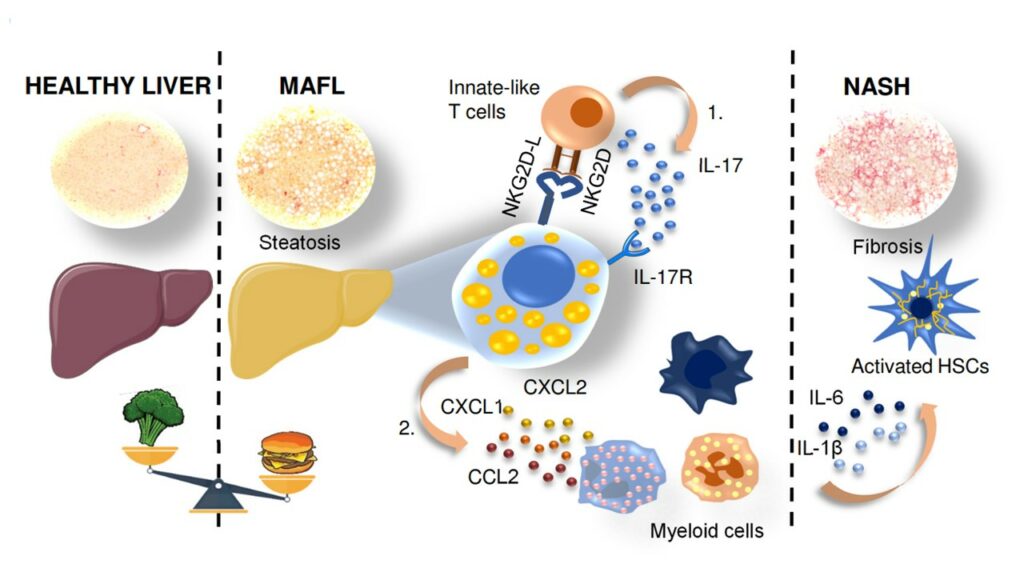Sonja Marinović, Maja Lenartić, Karlo Mladenić, Marko Šestan, Inga Kavazović, Ante Benić, Mia Krapić, Lukas Rindlisbacher, Maja Cokarić Brdov̌ak, Colin Sparano, Gioana Litscher, Tamara Turk Wensveen, Ivana Mikolašević, Dora Fučkar Čupić, Lidija Bilić-Zulle, Aleksander Steinle, Ari Waisman, Adrian Hayday, Sonia Tugues, Burkhard Becher, Bojan Polić, Felix M Wensveen “NKG2D-mediated detection of metabolically stressed hepatocytes by innate-like T cells is essential for initiation of NASH and fibrosis“, Science Immunology, 29. Sep 2023., Vol. 8, Issue 87, DOI: 10.1126/sciimmunol.add159
Here is what the authors told us:
This scientific paper investigates the initiation of inflammation and the development of fibrosis in fatty liver disease or steatosis. A large number of people with obesity (up to 40%) suffer from non-alcoholic fatty liver disease, which has several stages, the most benign of which is hepatic steatosis (fatty liver disease). In some cases (about 25%), hepatic steatosis turns into inflammation and liver fibrosis (non-alcoholic steatohepatitis or NASH), which can potentially lead to cirrhosis and liver failure. Given that the transition from steatosis to steatohepatitis (NASH) is a key event for the disease progression, we were interested in how the immune system is activated in the liver, that is, the onset of inflammation and fibrosis. We have observed that lipid accumulation in hepatocytes induces the expression of ligands (proteins) specific to the activating immune receptor NKG2D. We also observed that, when exposed to a high-fat diet, this receptor is increasingly expressed by innate-like T cells, especially gamma-delta T cells, which are normally present in liver tissue, that they are activated very early and that they secrete the pro-inflammatory cytokine IL-17. This cytokine further stimulates the pro-inflammatory cascade in which other immune cells participate as well, which ultimately causes inflammation and fibrosis. After we genetically removed NKG2D, liver inflammation and fibrosis did not develop despite steatosis. We obtained similar results after genetically removing gamma-delta T cells. In other words, we showed that the NKG2D receptor on gamma-delta T cells is crucial for the detection of metabolically stressed hepatocytes and the initiation of inflammation. In collaboration with the Department of Internal Medicine and the Department of General Pathology and Pathological Anatomy at the Clinical Hospital Centre Rijeka and the Center for Diabetes, Endocrinology and Cardiometabolism at Thalasotherapia Opatija, the clinical correlation revealed that human hepatocytes in fatty liver disease also express NKG2D ligands and that the number of NKG2D+ IL-17+ gamma-delta T cells increases and correlates with disease progression. In conclusion, our discovery of the mechanism of immune activation in fatty liver disease represents a basis for new therapeutic options and disease prevention, but it could also be useful in diagnostics. However, further clinical trials are needed to support this.
The paper resulted from years of hard work and was almost entirely carried out at the Department of Histology and Embryology of the Faculty of Medicine in Rijeka under the joint leadership of Felix Wensveen and Bojan Polić. Sonja Marinović, Maja Lenartić and Karlo Mladenić are the first co-authors of this paper, with the contribution of Marko Šestan, Inga Kavazović, Ante Benić, Mia Krapić and Maja Cokarić Brdovčak. Ivana Mikolašević, Tamara Turk Wensveen, Dora Fučkar Čupić and Lidija Bilić-Zulle contributed to the clinical part. Some of the necessary tools, reagents and expertise were provided by foreign partners, among whom we should mention Prof. Adrian Hayday (King’s College / Francis Crick Institute, London), Prof. Burchard Becher (University of Zurich), Prof. Ari Waisman (University of Mainz) and Prof. Alexander Steinle (University of Frankfurt).
The paper was published in the September issue of Science Immunology (IF = 30,658), which is ranked as one of the top scientific journals in the field of immunology.

